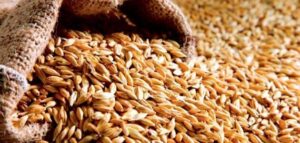
In its December report, the US Department of Agriculture (USDA) increased its forecast for global wheat exports in the 2025-2026 marketing year (MY) by 1.5 million tons to 218.71 million tons.
At the same time, the USDA raised its estimate of global wheat carryover stocks at the end of the season by 3.44 million tons to 274.87 million tons, indicating some easing of tensions in the global market.
With regard to Ukraine, the agency maintained its estimate of the wheat harvest at 23 million tons, but reduced its export forecast from 15 million tons to 14.5 million tons due to an increase in domestic consumption from 7.1 million tons to 7.6 million tons. This means that most of Ukraine’s wheat will be directed to the domestic market, while other supplier countries will provide the growth in global exports.

The volume of freight traffic carried by Ukrzaliznytsia in 2025 will decrease by 7% compared to last year, from 173 million tons to 160 million tons, and in subsequent years it will only be possible to increase it to 161 million tons and 162 million tons, respectively, the company announced to journalists during a presentation on November 7.
According to the presentation, it is expected that in 2025-2026, the volume of ore and manganese transportation will amount to 44 million tons compared to 43 million tons last year, and in 2027, it will decrease to 42 million tons.
Grain and flour transportation in 2025-2027 is forecast at 31 million tons, which is 22.5% or 9 million tons less than in 2024.
Ukrzaliznytsia noted that it expects a reduction in the transportation of building materials from 35 million tons in 2024 to 30-32 million tons in 2025-2027.
According to the presentation, coal transportation volumes in 2025-2027 will decrease by 17.4% compared to 2024, from 23 million tons to 19 million tons.
The company plans to partially offset these losses by increasing the transportation of other cargo from 32 million tons last year to 36 million tons this year, and then increasing it by 1 million tons annually.
Ukrzaliznytsia added that the total volume of cargo transportation from 2021 to 2025 decreased by 49% – from 315 million tons to 160 million tons. In particular, during this period, there was a 43% reduction in ore transportation, 52% in building materials, and 62% in coal.
According to the presentation, the forecast for the profitability of freight transportation is even worse: last year’s profit of UAH 20.4 billion will decrease to UAH 3.2 billion next year, and the following year, freight transportation will bring a loss of UAH 0.6 billion, and in 2027 – UAH 4.8 billion.
The company cites the freezing of tariffs, which were last increased in 2022, as the reason, although the producer price index has risen by 69.3% since then.
In September 2025, Valery Tkachov, deputy director of the commercial department of Ukrzaliznytsia, reported that the company expects freight traffic to decline this year to 162-165 million tons from 175 million tons last year, after partially recovering from a drop to 150-155 million tons in the first two years of Russia’s full-scale aggression from 312-315 million tons.
Tkachov then stressed that in order to rectify the situation, an active search for new cargoes is underway, in particular, retail and small and medium-sized business cargoes, ranging from forest products to industrial products and a large number of other segments.
Serhiy Leshchenko, deputy chairman of the supervisory board of Ukrzaliznytsia, reported last week in the Verkhovna Rada that the company’s net loss for the first nine months of this year amounted to UAH 7.195 billion.
According to him, the company proposes to index freight tariffs by 27.5% from January 1 next year and by another 11% from July 1.
The volume of Ukrzaliznytsia’s export shipments in January-June 2025 decreased by 13.5% to 38.7 million tons, domestic shipments by 11.7% to 35.5 million tons, while the volume of import transportation increased by 5.4% to 5.3 million tons.
In 2024, the company increased its revenue by 11.1% to UAH 102.87 billion, but incurred a net loss of UAH 2.71 billion compared to a net profit of UAH 5.04 billion in 2023.

According to the Food and Agriculture Organization of the United Nations (FAO) and the United States Department of Agriculture (USDA), global wheat production in 2025 is forecast to reach around 809.7 million tons, which is 1.3% higher than in 2024.
The growth is expected to be driven by increased yields in Canada, Kazakhstan, China, and India, while southern Europe and North Africa remain at risk of lower production due to drought.
“The outlook for the global wheat market remains generally positive, and global stocks at the end of the season will remain stable despite active exports from the Black Sea region,” the FAO Cereal Supply and Demand Brief notes in its October review.
Top 20 countries in the world by wheat production in 2025 (FAO and USDA estimates)
These twenty countries produce more than 90% of the world’s wheat.
Despite overall growth in yields, global wheat stocks could decline by 1.6% to around 312 million tons by the end of 2025. This is due to increased domestic consumption in Asia and the Middle East, as well as active exports from Russia, Ukraine, and Australia.
Average global wheat prices remain volatile, but FAO analysts predict their relative stabilization while maintaining harvest and stock volumes.
Despite the war, Ukraine retains its status as one of the largest grain exporters. According to estimates by the Ministry of Agrarian Policy, in the 2024–2025 marketing year, the country exported about 15 million tons of wheat, supplying it to Egypt, Indonesia, Spain, Turkey, and Tunisia.
Ukraine ranks 11th–12th in the world in wheat production and is among the top five global exporters thanks to its high yields and logistics routes through the Danube and Baltic ports.
A detailed overview of the world’s major wheat producers from 1970 to 2024 can be found in the Experts Club analytical video: Watch on YouTube

JSC “NAEK ”Energoatom” will be profitable in all three scenarios during 2025-2028, with profits in 2028 expected to be twice as high as in 2026-2027, due in particular to the expected rise in electricity prices.
This forecast is contained in the annual information on fiscal risks prepared by the Ministry of Finance of Ukraine based on data from 12 state-owned companies as part of the adoption of the 2026 state budget. Within the document, basic, alternative, and negative scenarios are modeled for each company based on macroeconomic scenarios for the development of Ukraine’s economy.
“Net revenues from NAEK Energoatom to the state budget are expected in all scenarios and will grow as the company’s profitability increases,” the document says.
As noted by its authors, NAEK plans to build new power units in the long term and has plans in the medium term to attract sufficient debt financing to fund investments. However, construction will continue after the end of the medium-term period, and if such construction is financed through debt obligations, high costs are expected to increase the company’s obligations to a level that it may not be able to service.
“Fiscal risks may materialize if the government has to provide funding to cover part of these costs, or if the government has to service Energoatom’s debts,” the Ministry of Finance concluded.
Under the baseline scenario, Energoatom’s capital expenditures will average about UAH 59 billion per year from 2025 without budget financing, while expenditures on PSO for tariff compensation for the population will decrease by an average of 2.3% in the period 2026-2028.
In addition, the baseline scenario assumes an average increase in electricity prices of 7.9% per year, as well as a slight decrease in the company’s electricity production in 2026-2027, followed by an increase in 2028.
As the Ministry of Finance noted, NAEK received a net profit of UAH 1.3 billion in 2024, compared to a loss of UAH 11.3 billion in 2023. Last year, the company demonstrated a 35% increase in revenue due to a 33.5% increase in the weighted average price of electricity.
According to the results of 2024, the volume of PSO in Energoatom amounted to UAH 109.3 billion, or 53% of the company’s net income for that year.

Consulting agency UkrAgroConsult forecasts a 5.7% decline in sunflower harvest in the 2025 season to 13.3 million tons from 14.1 million tons in the previous forecast due to drought in southern and eastern Ukraine, the agency’s press service reported.
“Crop losses are mainly observed in the southern and eastern regions, where drought has significantly affected crops. In contrast, the situation is more favorable in the northern and western regions, where rains have been regular. Sunflower yields are expected to increase during harvesting in the northwestern belt, as was the case with wheat and barley,” the agency said.
Analysts added that market estimates of the sunflower harvest range from 12.8 to 13.5 million tons. Therefore, UkrAgroConsult sticks to the upper end of the estimate due to the expansion of acreage in the west and north after the start of the war. However, seed quality is a concern due to diseases caused by rains during harvesting in these regions.
UkrAgroConsult has more optimistic forecasts for corn.
“The main growing regions have sufficient moisture levels, and crops in the south account for a small share. This year’s pollination and grain filling period coincided with more favorable temperatures compared to last year, and periodic rains contributed to crop development,” experts said.
Market estimates of the corn harvest range from 28 million tons to 35 million tons, but at the end of July, UkrAgroConsult raised its forecast by 2 million tons to 32.5 million tons, or 6.6%, which is one of the highest figures on the market.
UkrAgroConsult’s wheat harvest forecast remains stable at 22 million tons. As of August 7, almost 15 million tons had been harvested from 74% of the planted area. The remaining 26% is in regions with the highest yields, which gives grounds for optimism, the agency concluded.

The National Bank of Ukraine (NBU) has lowered its forecast for the 2025 vegetable harvest by 11.5% to 7.6 million tons, fruit and berry harvest by 11.1% to 1.8 million tons, and potato harvest by 3.4% to 19.4 million tons.
“Weather conditions in the spring of 2025 were unfavorable for harvests. Spring frosts covered a significant part of the country, causing particular damage to winter crops, fruit and berries, and vegetables,” the National Bank said in its updated Inflation Report published this week.
At the same time, compared to last year’s harvest, the National Bank estimates that this year’s vegetable harvest will be 11.5% higher, or 0.8 million tons, and potato harvest will be 10.7% higher, or 1.9 million tons.
However, the situation with fruits and berries is worse, and their harvest will be 12.4%, or 0.2 million tons, less than last year.
The National Bank also lowered its forecasts for vegetable crops in 2026 by 9.1% compared to the previous April Inflation Report, to 8.0 million tons, and for fruit and berries by 4.0%, to 1.9 million tons.
At the same time, the NBU slightly improved its expectations for next year’s potato harvest by 0.7% to 20.0 million tons.